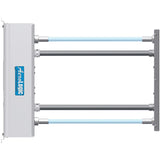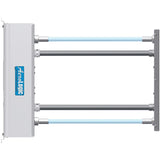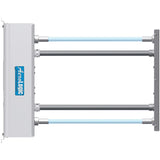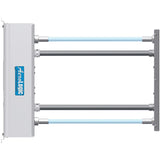UVC Lighting Solutions for Navy Ships, Cruises, Yachts
Posted by Nick on for ProLampSales
Large naval vessels are compact environments where microbes can thrive, circulating through the ventilation system.
After a certain amount of time, it is likely that every person aboard a ship is exposed to dangerous microorganisms that cause respiratory infections, the flu, and other illness.
Many vessels are equipped with HEPA or HEPA-like air filters, but MERV 14 filters are not guaranteed to protect against small organisms like viruses and bacteria. They can help filter mold and fungal spores, which are larger.
The danger from airborne microorganisms in a Navy ship, cruise ship, or yacht should not be understated. In one study on tuberculosis aboard a Navy ship, airborne transmission through the ventilation system was responsible for the majority of secondary infections. And in another study, noroviruses and Norwalk viruses have been found responsible for gastroenteritis outbreaks on cruise ships from fomites on the surface of the vessel.
The following is a list of respiratory pathogens that have been found onboard airlines or marine vessels.
- Adenovirus
- Chickenpox
- Coronavirus
- Influenza
- Legionnaire's Disease
- Measles
- Mumps
- Mycobacterium tuberculosis
- Neisseria meningitidis
- Norovirus
- Norwalk viruses
- SARS
Cleaning just surfaces, such as with handheld units spread throughout the ship, will not be enough to reduce the risk of disease transmission.
Air Sanitizing Systems
While many vessels are outfitted with an air filter, it may not be enough to stop the transmission of bacteria and virus based illnesses. Upgrading to a higher-quality air filter is one option, but ultraviolet germicidal irradiation systems should also be installed.
In-Duct HVAC systems provide continuous treatment of air through a ship and can be installed in one or multipe areas in the ducts. As air is pumped through the system and then recirculated, it is passed over the UVC light bulbs, helping reduce the number of pathogens in the air.
This is also the safest option, as the ultraviolet bulbs are contained in the ducts. The bulbs themselves can also be coated with an armor shielding that renders them nearly unbreakable, almost completely eliminating the risk of mercury exposure.
Also, some in-duct HVAC UVC systems can be outfitted with a monitoring device that provides the status of the bulbs. This gives the ship maintenance personnel feedback on whether the bulbs are malfunctioning or need changing, without having to turn the system completely off or check on the bulbs manually.
Surface Cleaning
Some ships are large. Even smaller yachts can be a large project to clean, and making sure every surface gets enough UVC disinfection exposure is nearly an exercise in futility.
While surface irradiation can be extremely effective, it is very temporary. As soon as the area is no longer receiving UVC light, bacteria, mold, viruses, and fungal spores begin landing on that surface again, as they travel though the air.
Full room disinfection units can significantly reduce the number of pathogens in a confined area, and handheld UVC devices can irradiate areas, but these should not be considered the main form of ultraviolet disinfection. They are a great supplement for spot cleaning, but their effects end as soon as the devices are turned off.
For cruise ships or naval vessels that have a clinic or medical area for treating patients, portable UVC room fixtures offer a solution for disinfecting examination rooms between patients. These units can take a while to work, from 15-60 minutes depending on the size of the room and power of the equipment.
UVC for Marine Vessels Proven to Help
While it is harder to clean larger ships, studies have shown that the incidence of respiratory diseases increases in smaller vessels. People are closer together, and the ventilation system is smaller overall, allowing the spread of harmful pathogens.
However, instead of just installing higher-quality air filters, a UVGI system can be both more effective and more affordable. In fact, keeping the filter the same and adding in a UVC lighting air disinfection unit will cost provide better energy efficiency than just upgrading the filter.
Combined with a ventilation system UVC light, handheld units can reduce the the number of pathogens in certain high-traffic, high-risk areas, such as bathrooms, offices, or anywhere fomites can harbor dangerous germs.
- Posted in Health, Ultraviolet Light
Featured Products (View All)
0 Comments




